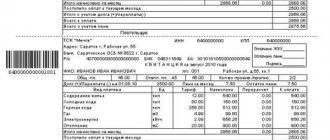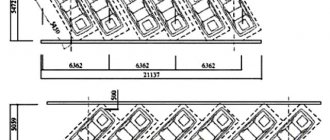- home
- Legal support of construction
- Commissioning of the facility
- Certificate of commissioning of non-residential premises
Author of the material: Magomedov David Shakhlarovich
Land law lawyer, work experience - more than 2 years
auto RU
Whatever the purpose of the premises - technical, commercial, or industrial - its legal use is impossible without the final point in the form of a commissioning act. It doesn’t matter whether it was construction from scratch or reconstruction - you can’t do without this document. Almost.
Is commissioning of non-residential premises always necessary?
First, let's clarify something. Not every non-residential building requires the hassle of permitting documents. They are not needed if you:
- a utility building or garage that will not be used for profit;
- commercial sheds, kiosks and buildings that do not meet the definition of capital construction.
So a bathhouse can be built on a summer cottage without official notifications or permits. With more serious non-residential buildings, it is impossible to do without commissioning the premises. Otherwise, the object cannot be registered and the rights to it cannot be registered (read: it is impossible to use and dispose of it).
To register ownership rights, you will have to confirm that construction or reconstruction has been completed in accordance with project documentation and construction and technical standards. This means that all this documentation must be there. As well as:
- registration of the project in the information system for supporting urban planning activities (ISOGD);
- issued construction permit;
- accepted notice of the beginning and completion of construction work;
- completed work logs.
How to draw up a certificate of commissioning of a residential building
Naturally, the owner is not obliged to draw up the act himself, especially since there is already a recorded form for citizens of the Russian Federation where they can enter their data. You need to know the main points, at least in order to insure your own property, and be aware of what is happening to it.
As already mentioned, the act is issued only after it is approved by the commission. But there are times when one of the commission members does not sign. In this case, he must make a conclusion about the deficiencies that the developer will correct by the specified date. If he does not do this, the house will not be put into operation. Such a decision can be appealed in court. If everything is fine, then in order to receive an acceptance certificate, the document must be approved by the head of the architectural committee or his deputy.
As for the contents of the act, since this is a state-issued document, it requires the following to be indicated:
- The entire composition of the commission that carried out the acceptance of the object is listed. This is easy to do, since all members of the commission must sign the document;
- Date of inspection;
- The place where the construction project is located;
- What is the nature of the object. Residential, as well as commercial and administrative buildings can be distinguished;
- The structural parts of the building that need to be put into operation are indicated.
Particular attention should be paid to communications. This point is fundamentally important, because the comfort of the people living in the house depends on the quality of communications. Highlight:
- Water supply. Obtain information about its readiness from the fact whether it is connected to a local or central water main;
- Electrical supply. The readiness of the electrical network can be guessed by the facts of whether power lines are installed and whether electricity is connected;
- Sewerage. This industry has its own specifics, which lies in where exactly the residential building is located. If a person lives in a city, then the presence of sewerage is a prerequisite. But in suburban construction, the system in question is not needed, since there is no central sewage system, and people get out as best they can.
- Heating. This system is also necessary, since our climate simply does not allow living with open windows all year round. But an improperly designed system can cost residents their lives. These are too high a price for the relative warmth in the house.
The act of commissioning non-residential premises - we go through the stages
The process of drawing up a certificate of commissioning of non-residential premises can be divided into three stages.
At the first stage, the contractor sends a written notification to the customer about the completion of construction work. An approximate list of documents attached to it:
- certificate of completion;
- working drawings;
- a list of organizations involved in construction or reconstruction, as well as the supply of communications;
- acts of acceptance of individual and hidden works;
- production journals with author's supervision.
The second stage - a working commission is created from representatives of the customer, the design organization, operation services and state supervision. If the construction documentation is completed correctly and the work performed is in accordance with the project, a conclusion is drawn up on the readiness of the premises for acceptance into operation.
At the third stage, the acceptance committee determines the compliance of the object with the design documentation and assesses its suitability for operation. Based on the results of the work of the selection committee, that very cherished act is drawn up. The date of approval of the act by the head of the architectural department is the moment the premises are officially put into operation. All that remains is to survive all these checks and commissions.
| Name | Price for individuals persons | Term |
| Telephone consultation | 0 rub. | Individual |
| Detailed consultation with analysis of documents in the office (Skype, etc.) | from 5,000 rub. | 1 hour |
| Commissioning of non-residential premises | from 15,000 rub. | from 7 working days |
Certificate of acceptance of the object into operation: sample
A sample act is here.
ACT OF ACCEPTANCE - DELIVERY OF THE OBJECT
according to contract No. 463/4 dated August 16, 2016
Moscow August 20, 2020
We, Zolotoy Dom LLC, represented by General Director Mikhail Pavlovich Bordakovsky, hereinafter referred to as the Contractor, on the one hand, and Wizard LLC, represented by General Director Alexander Romanovich Vershagin, hereinafter referred to as the Customer, on the other hand, have drawn up this Act among ourselves about the following:
- The Contractor handed over, and the Customer accepted, the facility (retail premises), located at the address: Moscow, st. Lomonosova, house 241, bldg. 3, apt. 18, tel. after carrying out repair, construction and finishing work (*construction and/or decorative, artistic work) in accordance with the estimate documentation with proper quality.
- All payments for all work performed were made by the Customer in full and within the time limits established in the above Contract Agreement.
- The Customer received from the Contractor all the keys to the above facility.
- From the moment of signing this Act, the Contract Agreement is considered fulfilled by both parties in full.
- From the moment of signing, this Act serves as the beginning of the guarantee day for the repair, construction and finishing work carried out.
- This Transfer Certificate is signed in 2 (two) copies of equal force, one of which is transferred to the Contractor, the second is transferred to the Customer.
Acceptance certificate for a capital construction project: sample.
Read here how to buy an apartment in a new building.
How to draw up an act of acceptance and transfer of an apartment under an equity participation agreement, read the link:
Contractor: _________________________M.P. Bordakovsky
M.P.
Customer: __________________________ A.R. Vershagin
I have no complaints.
You don't have to figure it out yourself
Obtaining permission to operate a constructed or reconstructed facility is not easy, even with a clear plan. Organizing a commission, obtaining certificates, filling out acts, going through authorities takes time and effort from both beginners and experienced builders.
This is accompanied by confusion with the jurisdiction of a specific premises on the territory of Moscow: either to the structures of the capital itself inside the Moscow Ring Road, or to “New Moscow”. And there is also a subordinate city of Zelenograd. Until you find someone to go to for permits.
This is why it is better to separate construction and legal tasks. For a solution to the latter, please contact the Land Lawyer company. By collaborating with highly qualified cadastral engineers and technical specialists, we will save you from communicating with officials and confronting bureaucracy. Sign up for a consultation and we will draw up a detailed action plan for you, taking into account your specific situation and current legislation.
Acceptance certificate
The contractor delivers the result of his work to the contractor in accordance with the construction contract. The fact of acceptance of a capital construction project is recorded by drawing up and signing a corresponding act.
There are approved forms of such an act - KS-2 and KS-11:
- Form KS-2 is intended for acceptance of a certain part of construction within the entire facility and for acceptance of a stage of work.
- Form KS-11 is used when a capital construction project is accepted in full.
The conclusion on the acceptance of a construction project, depending on the type of object, is issued by an authorized federal executive body or an authorized executive body of a constituent entity of the Russian Federation. The federal authorities are in charge of hazardous production facilities, communication lines, and technically complex and unique facilities. After the final inspection and assessment of the work performed, a decision is made to issue a conclusion on compliance or to refuse to issue such a conclusion. The inspection begins after the developer or customer contacts the construction supervision authority. A conclusion or refusal to issue a conclusion is issued within 10 days from the date of application.
The next stage is the commissioning of the capital construction project. Commissioning requires a permit certifying the completion of construction, major repairs, reconstruction of a capital construction project in accordance with the urban planning plan and design documentation. Permission to put a facility into operation after an application from the developer is issued by the body that issued permits for the start of capital construction. The decision to commission the facility or refuse must be issued within 10 days from the date of submission of the application.
Permission to put a capital construction project into operation is issued upon submission of the following documents:
- Title documents for the land plot on which capital construction was carried out.
- Urban planning plan of the land plot.
- Construction permit.
- Layout of the capital construction project, plan of engineering and technical support networks on the land plot, planning organization of the land plot. These documents must be signed by the developer or the customer if the construction was carried out on the basis of a contract
- Conclusion on the compliance of capital construction with the requirements of technical regulations and design documentation.
- Information about the capital construction project, engineering support networks, copies of engineering survey results and sections of design documentation provided for by the Town Planning Code of the Russian Federation.
- Certificate of acceptance of a capital construction project, if construction was carried out on the basis of a contract.
- Document on the compliance of capital construction with the requirements of technical regulations.
- Confirmation of compliance of construction parameters with project documentation.
- Confirmation of compliance with technical specifications.
What it is
Let's start with the question “Why is it needed at all?” I think you asked a similar question. But the whole point is that in order to obtain permission to put objects into operation, it is necessary to prepare a certain list of documents established in Part 3 of Art. 55 Civil Code of the Russian Federation.
This is interesting: Alimony from the unemployed in 2020 in Russia: calculation, collection, sample application
This act is one of these documents. Nobody issues it; it is filled out by the developer or the customer together with the person carrying out the construction (general contractor), the person who prepared the design documentation (general designer) and the operating organization.
This act is also called form KS-11.
What form of act should be used?
First of all, it is worth recalling that since these forms are no longer mandatory, their use for specific objects must be stipulated in the construction contract. But which form should be used?
Goskomstat of the Russian Federation in its Resolution No. 71-a dated October 30, 1997. approved two almost identical documents - KS-11 and KS-14 - which are used to accept fully completed construction.
This is interesting: Statement of claim for deprivation of parental rights and collection of alimony - sample claim for deprivation of parental rights and collection of alimony
However, these documents have significant differences that determine their scope and order of application:
- when drawing up the KS-14 act, one of the parties that participates in the acceptance of the object is the acceptance committee. This commission is formed by the customer or investor. But when drawing up the KS-11 act, only two parties are involved - the contractor (performer) and the customer (investor);
- the KS-14 form serves not only to accept the object, but also to recognize it as a fixed asset and to put it into operation. Act KS-11 serves only as confirmation of the acceptance of the object when it is fully ready and is then used when preparing documents for the commissioning of the object and when it is included in the fixed assets;
- KS-14 is used when accepting objects that were built, including through concessional lending funds;
- with the help of KS-14, information is reflected on the operation of all communications at the facility, on the compliance of the commissioned facility with the project, and with construction and other standards. The KS-11 act reflects the compliance of the finished facility with the approved design data;
- if KS-11 indicates the acceptance of the object by signing the act by the contractor and the customer, then KS-14 serves as confirmation of the acceptance of the object only after the corresponding decision has been made by the acceptance committee. This decision is made in the CC-14 act itself, which is signed only by the commission.
Act KS-14 is drawn up when the current legislation (Article 753, Civil Code of the Russian Federation) accepts an object only if there is an appropriate commission consisting of representatives of the following supervisory authorities:
- sanitary and epidemiological;
- environmental;
- fireman;
- architectural and construction;
- and other interested structures.
In all other cases, form KS 11 is used.









